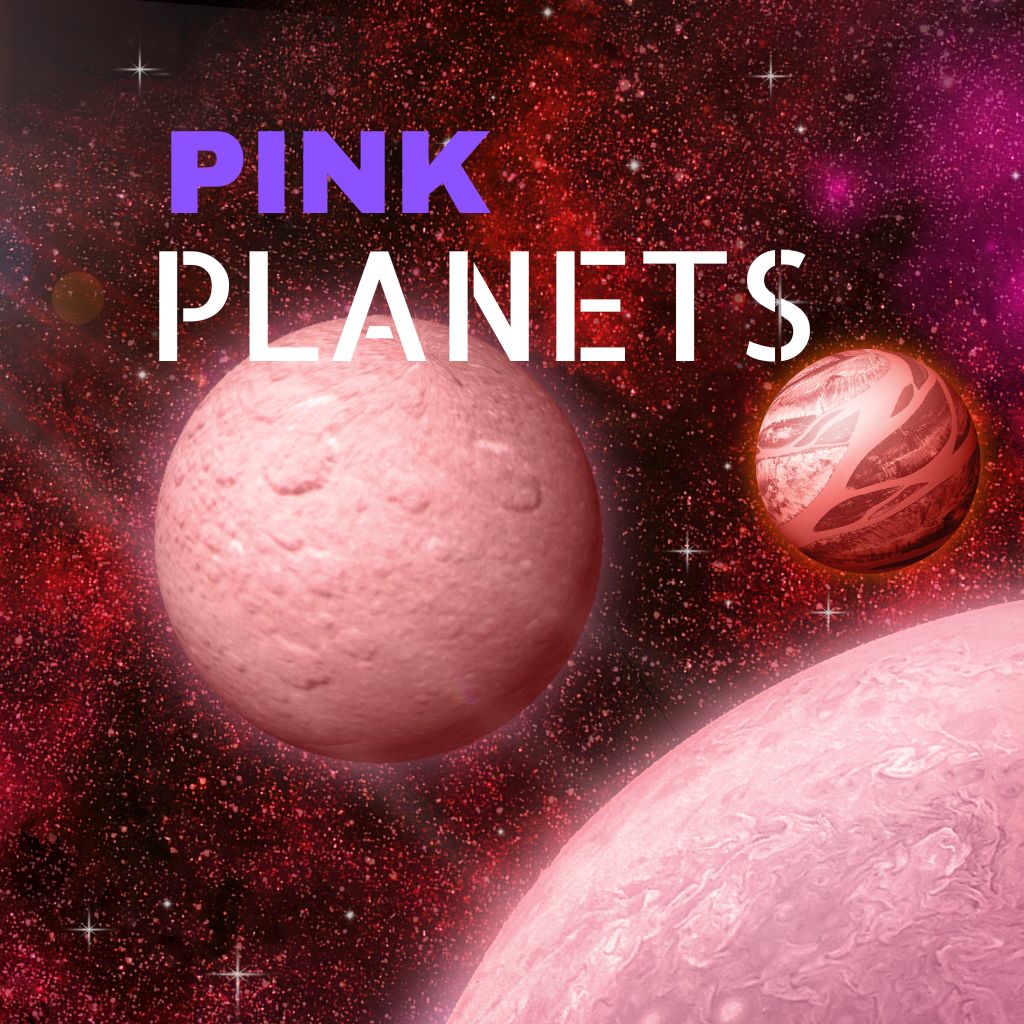This site contains affiliate links to products. I may receive a commission for purchases made through these links.
Just as there are myriad colors in nature on Earth, so too does the universe surprise us with its chromatic splendor.
The possibility of a pink planet challenges our traditional understanding of what a celestial body can look like and opens up the multi-hued tapestry of our solar system.
Knowledge about pink planets is more than just an intriguing factoid for astronomers and space enthusiasts. It’s a testament to the variety and complexity of the universe surrounding us, hinting at the potential for life in unusual environments and challenging our knowledge of planetary science.
Educators, students, scientists, and curious minds might want to know more about these celestial curiosities. These vibrant worlds inspire questions about the fundamentals of our reality and the nature of the universe.
The discovery and ongoing study of these planets mark significant advancements in space exploration, broadening our understanding of the universe beyond our solar system.
In this article, we will answer all the burning questions about pink planets, their age, their solar system, and their distance from us. We will explore pink dwarf planets and ways to observe them.
Does a pink planet exist?
There is a pink planet known as GJ 504b. It is an exoplanet, a planet that orbits a star outside of our solar system. GJ 504b is a gas giant similar to Jupiter but with a distinct pinkish hue.
GJ 504b is notable for its striking magenta color, reminiscent of a dark “cherry blossom,” a term used by astronomers due to its pinkish hue.
This fascinating color is likely due to the planet’s high temperature, which results in a cloud-free atmosphere and clear visibility of the deep, hot layers of the planet’s atmosphere.
GJ 504b surpasses Jupiter in size, being four times more massive. The core accretion theory, which explains how Jupiter-sized planets form, might not be applicable to GJ 504b due to its unique characteristics.
This captivating pink planet was discovered by a team of astronomers using the Subaru Telescope, an 8.2-meter flagship telescope of the National Astronomical Observatory of Japan, located at the Mauna Kea Observatory in Hawaii.
The discovery of GJ 504b was announced to the public in 2013. The process of discovering exoplanets like GJ 504b often involves complex methods such as the radial velocity method and the transit method.
However, GJ 504b was found using direct imaging, a method that involves taking photographs of a star and analyzing the images to identify any orbiting bodies.
This method is usually only effective when the planet is large (like a gas giant) and far from its parent star, as is the case with GJ 504b.
How old is the pink planet (GJ 504b)?
GJ 504b is estimated to be about 160 million years old, significantly younger than our own 4.5 billion-year-old Earth.
What solar system harbors the pink planet?
The pink planet, GJ 504b, resides in the solar system of the star GJ 504, which is part of the constellation Virgo.
GJ 504b orbits its central star, GJ 504, at nearly nine times the distance Jupiter orbits the Sun, providing a compelling example of the diversity of exoplanetary systems.
How far away is the pink planet?
GJ 504b is approximately 57 light-years away from us. In terms of space travel, it is beyond our current capabilities to reach.
Does a pink planet exist within our own solar system?
There is no known pink planet in our own solar system. GJ 504b doesn’t exist within our own solar system. However, there are gas giants like Jupiter and Saturn that exhibit bands of different colors, including red, orange, and brown.
These colors are primarily due to the presence of various atmospheric gases and cloud compositions.
Which dwarf planet is pink in color?
Image Credit: Roberto Molar Candanosa/Carnegie Institution for science
A pink dwarf planet, nicknamed “Farout,” has been discovered on the outskirts of our solar system. Officially named 2018 VG18, Farout’s pink hue is due to the presence of ice-rich material on its surface.
Can you observe the pink planet with a telescope?
Observing pink planets like GJ 504b requires advanced equipment because it is located outside our solar system.
Although it is faintly visible from Earth due to its immense distance, GJ 504b continues to intrigue scientists with its alluring pink hue.
However, for planets within our solar system, certain telescopes such as Celestron NexStar 8SE will provide clear views of their features.
You may also like: How To Detect Exoplanets (You Can Do It From Home)
FAQs about planets
Let’s address some frequently asked questions.
How do planets get their color?
The color of a planet can be determined by various factors, such as the chemical composition of its atmosphere, its surface materials, and the way these elements interact with sunlight.
Can a planet’s color change over time?
A planet’s color can change over time due to geological or atmospheric changes.
How do we know what color an exoplanet is if we can’t see it directly?
Scientists use methods such as spectroscopy to analyze the light that exoplanets reflect, absorb, and emit, which can provide clues about their color.
Are there any benefits to a planet being pink?
The color of a planet doesn’t directly bestow benefits or disadvantages. However, the elements causing the color could have implications for the planet’s climate, potential for life, and other aspects of its nature.
Could life exist on a pink planet?
Life, as we understand it requires specific conditions, but the universe is full of surprises. The possibility can’t be entirely ruled out until further research is conducted.
What other colored planets exist?
There are various colored planets in the universe, including red like Mars, blue like Neptune, yellow-white like Venus, and even black planets like TrES-2b.
Does a purple planet exist?
There are no known purple planets in our solar system. However,, there could potentially be planets of this color.
Does an orange planet exist?
Venus can appear orange due to its thick atmosphere full of carbon dioxide and clouds of sulfuric acid.
What planet is pink and white color?
Currently, there is no known planet with a distinct pink and white coloration. Neptune exhibits pink-white methane ice clouds located higher in its atmosphere compared to its blue gaseous atmosphere.
Interestingly, the coloration of the planet’s clouds is attributed to the presence of trace gases within its Jovian atmosphere rather than the dominant hydrogen or helium elements.
Which planet in the universe has a pink sky?
Mars can sometimes have a pink or salmon-colored sky due to the dust in its atmosphere.
Does a rainbow planet exist?
Mercury exhibits a wide array of colorful minerals, as depicted in an image captured by NASA’s MESSENGER spacecraft.
Utilizing data collected during its mission to study the surface and tenuous atmosphere of Mercury, MESSENGER produced a false-color image showcasing the diverse hues of minerals present on the planet’s surface.
Takeaway: The existence of a pink planet serves as a reminder of the remarkable vibrancy that permeates the cosmos
Pink planets like GJ 504b do exist, although none are in our solar system. GJ 504b, about 57 light-years away, is found in the solar system of the star GJ 504.
GJ 504b is a giant gas planet, an exoplanet with a gaseous structure much like Jupiter or Saturn in our solar system.
As a giant planet, GJ 504b has stirred the curiosity of scientists and space enthusiasts, challenging our understanding of planetary formation and properties.
The dull magenta of GJ 504b, often compared to cherry blossoms, offers a captivating example of the wide spectrum of planet colors in the universe.
Given the unique features and location of GJ 504b, we have to consider alternative formation theories that might explain its existence.
A pink dwarf planet, “Farout,” also exists at the fringes of our solar system. In the vast, colorful universe, the possibilities are as endless as space itself.
The discovery of a pink planet unveils the captivating and colorful nature of our universe. It serves as a testament to the intriguing diversity of exoplanets and their unique atmospheric compositions.
Through careful observations and scientific advancements, we continue to unravel the mysteries of these distant worlds, expanding our understanding of the cosmos and the potential for life beyond Earth.
The pink hues found on GJ 504b and the distinct colorations of other planets, like Neptune’s pink-white methane ice clouds, demonstrate the fascinating role that atmospheric conditions and trace gases play in shaping their appearances.
Each new revelation brings us closer to unraveling the profound secrets of the cosmos and deepening our appreciation for the sheer beauty and diversity beyond our home planet.
Don’t forget to subscribe to our newsletter where you’ll find the latest cosmic discoveries, expert stargazing tips, and exclusive subscriber deals. Embark on your cosmic journey if you haven’t already!
You may also like:
- 13 Prettiest Planets in the Universe (w/ Pictures)
- Which Planets Can Be Seen Without a Telescope? (Answered!)
- Can I See Planets With a Cheap Telescope?
- 21 Best Telescopes to See Planets (Read This First!)
- 13 Tips for Finding and Observing Planets through a Telescope
- 19 Most Dangerous Planets Known to Man (Quick Facts)




